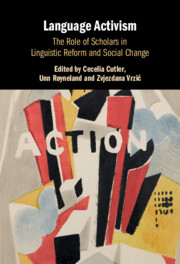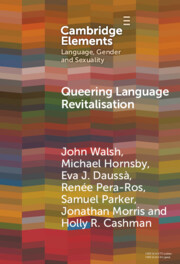Refine search
Actions for selected content:
93 results
6 - Social Aspects of Translating
-
- Book:
- Fundamentals of Translation
- Published online:
- 04 December 2025
- Print publication:
- 11 December 2025, pp 163-198
-
- Chapter
- Export citation
Dispelling some misconceptions of English-medium instruction
-
- Journal:
- English Today , First View
- Published online by Cambridge University Press:
- 03 November 2025, pp. 1-8
-
- Article
-
- You have access
- Open access
- HTML
- Export citation
The words that keep people apart: official language and accountability
-
- Journal:
- Journal of Institutional Economics / Volume 21 / 2025
- Published online by Cambridge University Press:
- 01 October 2025, e35
-
- Article
-
- You have access
- Open access
- HTML
- Export citation
Bogged down ELT, bailed-out CLT?: Translanguaging steps in A context-sensitive response to Bangladesh’s ELT crisis
-
- Journal:
- English Today , First View
- Published online by Cambridge University Press:
- 16 July 2025, pp. 1-8
-
- Article
- Export citation
EMI policy and practice divides in China, Japan, Malaysia and Nepal: Policymakers’ neoliberal ideologies and multilingual classroom realities in higher education
-
- Journal:
- English Today , First View
- Published online by Cambridge University Press:
- 13 June 2025, pp. 1-7
-
- Article
-
- You have access
- Open access
- HTML
- Export citation

Language Activism
- The Role of Scholars in Linguistic Reform and Social Change
-
- Published online:
- 31 May 2025
- Print publication:
- 06 February 2025
Reflection on Japan's language policy for English loanwords: Policy aims and media usage analysis
-
- Journal:
- English Today / Volume 41 / Issue 2 / June 2025
- Published online by Cambridge University Press:
- 28 April 2025, pp. 127-136
- Print publication:
- June 2025
-
- Article
-
- You have access
- Open access
- HTML
- Export citation
Race, Language, and Contested Solidarities: The Heritage-Language and Black Cultural-Heritage Programs in Ontario in the 1970s and ’80s
-
- Journal:
- History of Education Quarterly / Volume 65 / Issue 2 / May 2025
- Published online by Cambridge University Press:
- 31 March 2025, pp. 169-195
- Print publication:
- May 2025
-
- Article
-
- You have access
- Open access
- HTML
- Export citation
“Don’t You Think That We’ve Reached an Extreme?”: The Issue of TV Broadcast Language in Soviet Latvia, 1955–71
-
- Journal:
- Nationalities Papers / Volume 53 / Issue 6 / November 2025
- Published online by Cambridge University Press:
- 04 March 2025, pp. 1290-1309
-
- Article
-
- You have access
- Open access
- HTML
- Export citation
1 - Introduction
-
-
- Book:
- Language Activism
- Published online:
- 31 May 2025
- Print publication:
- 06 February 2025, pp 1-12
-
- Chapter
- Export citation
10 - The Researcher’s Role in Language Policy Processes
- from Part III - Activism in Minoritized and Endangered Language Communities
-
-
- Book:
- Language Activism
- Published online:
- 31 May 2025
- Print publication:
- 06 February 2025, pp 136-146
-
- Chapter
- Export citation
Beyond the ‘standard’ - Bertus van Rooy, World Englishes: The Local Lives of a Global Language. 1st ed. Edinburgh: Edinburgh University Press, 2024. Pp viii+230. Paperback, £24.99. ISBN: 9781474486309.
-
- Journal:
- English Today / Volume 41 / Issue 1 / March 2025
- Published online by Cambridge University Press:
- 23 January 2025, pp. 65-67
- Print publication:
- March 2025
-
- Article
- Export citation

Queering Language Revitalisation
- Navigating Identity and Inclusion among Queer Speakers of Minority Languages
-
- Published online:
- 08 January 2025
- Print publication:
- 30 January 2025
-
- Element
- Export citation
5 - Language Policy and Legal Fiction
-
- Book:
- The Coming of the Kingdom
- Published online:
- 29 November 2024
- Print publication:
- 12 December 2024, pp 223-261
-
- Chapter
-
- You have access
- Open access
- HTML
- Export citation

Language Policy in Action
-
- Published online:
- 05 December 2024
- Print publication:
- 12 December 2024
3 - Policy Change in a Language Regime
- from Part I - Routes of Change
-
-
- Book:
- States of Language Policy
- Published online:
- 14 November 2024
- Print publication:
- 21 November 2024, pp 49-65
-
- Chapter
- Export citation
4 - The Decline and Rebirth of Manx Gaelic
- from Part I - Routes of Change
-
-
- Book:
- States of Language Policy
- Published online:
- 14 November 2024
- Print publication:
- 21 November 2024, pp 66-83
-
- Chapter
- Export citation
1 - Introduction
- from Introduction
-
-
- Book:
- States of Language Policy
- Published online:
- 14 November 2024
- Print publication:
- 21 November 2024, pp 3-26
-
- Chapter
- Export citation
7 - African State Traditions and Language Regimes
- from Part II - Dependent Relationships
-
-
- Book:
- States of Language Policy
- Published online:
- 14 November 2024
- Print publication:
- 21 November 2024, pp 127-149
-
- Chapter
- Export citation
2 - Universalism as a State Tradition in Norway and Its Impact on Language Policy Choices
- from Part I - Routes of Change
-
-
- Book:
- States of Language Policy
- Published online:
- 14 November 2024
- Print publication:
- 21 November 2024, pp 29-48
-
- Chapter
- Export citation
